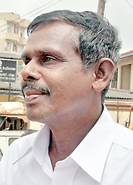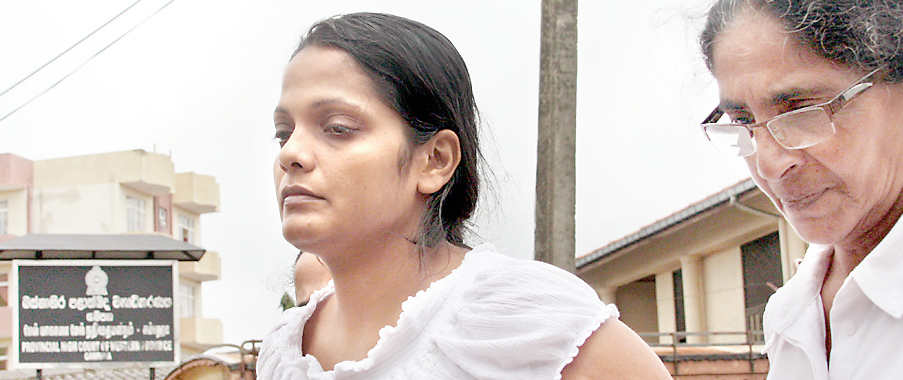News
The army’s licence to kill dissent in cold blood
Family members of two schoolboys killed in the Weliweriya shooting incident, described at the magisterial inquiry on Friday, their nightlong futile search for their children. It was only the following day they were able to get any information, Gampaha Chief Magistrate Tikiri K. Jayatilleke heard from Priyangika Shiromini Jayawardena, 35, mother of student Akila Dinesh (17). On hearing the sound of gunfire, she tried to go in search of her son, but was prevented by people who warned her of firing from all directions.

Ravishan’s father
“I returned home around 6.45 pm, and was told my son was seen in the church,” she said. “A few minutes later, we heard that the church had also been attacked. Later, I was told he was in the convent. Around 1 am, I tried to go looking for him again, but was prevented. I did not have any information about him.”
“I went to Weliweriya town around 5.30 am the next day, but could not find my son,” she continued. “I went to the church, too. At the police station, they said they had no record of my son, and told me to check the hospital.” “I found my son’s body at the hospital,” she related. “He had gunshot injuries including on his face.” She was told the army had shot her son.
Kumudini Jayawardena, Akila’s aunt, said she had called her sister with information about the shooting. “I checked later in the night, but they had not received any information,” she recounted. “It was only the following day that I was told the boy had been killed.”
Anthony Patrick Perera, 55, father of student Ravishan Perera who was also killed, told the inquiry he was at his office in Ampara, when he was asked to return home.
“When I got back, my son was in the Intensive Care Unit of the National Hospital in Colombo,” he said. “I visited him and on my return home, was told he had passed away.”
Krishantha Perera, 30, a relative of Ravishan, described how he had gone looking for Ravishan despite objections from his mother. “When I reached the junction, the army had put up barricades,” he said. “They had weapons and clubs. They told us not to proceed. We were forced to return home. It was only the next day that we found Ravishan had been taken to the Wathupitiwala hospital before being transferred to the National Hospital.”

Still in shock: Akila’s mother being given a hand after the inquiry
“We visited him in hospital,” he narrated. “He had a plaster on his head and eyes. He was connected to an oxygen tank. We felt he was breathing slightly, but passed away the next day.” Mr. Perera said a doctor had told him Ravishan’s death was caused by gunshot injuries and that the firing had taken place from a distance.
Attanagalla Assistant Superintendent of Police, Jayalath Balagalla, 50, said, “When I visited Rathupaswala the day before the incident, there had been about 100-150 people protesting. A Buddhist monk was staging a fast. The next day, he was on duty near the Venigros factory where there was a group of protesters too.
Thereafter, he was instructed to protect the Weliweriya Police Station on the assumption that there might be an attack there. “In town, I saw about 1,500 to 2,000 protesters,” he described. “Crowds were blocking the road, preventing the movement of vehicles. They had a coffin and wreath.”
“I appealed to them to disperse,” he continued. “Some agreed, but others continued. I begged them to allow ambulances and school vans to pass through.” “Around 3 p.m., I was informed by the Superintendent of Police that another group had got involved in the protest,” ASP Balagalla said. “I was warned they will attack the police station and policemen. But they passed by without incident. The riot squad, water cannon and STF stayed on till 6 p.m.”
“Later, Brig. Deshapriya Gunawardena came and informed the crowds of a decision taken at a meeting in the Defence Ministry,” he said. “He came to Weliweriya police station and then went on foot towards the protesters. I saw him make a speech. Some clapped. Three armoured vehicles were moving away.”
“However, some people did not move away from the road,” he explained. “I saw people throwing bottles and stones in the direction of the soldiers. There were about 3,000 to 4,000 persons. I heard sounds of firing from the direction of the crowd.”
Asked why police did not use water cannon and tear gas to disperse the protesters, he said it was not done because the army was among them. Subsequently, water cannon and tear gas were used. ASP Balagalla said people hiding behind buildings continued to throw stones at army and police.
Water supply to Weliweriya on fast-track
The National Water Supply and Drainage Board (NWSDB) has belatedly started laying pipelines in Weliweriya and several surrounding areas, including Nedungamuwa, where the contentious glove factory is located. Water Supply Minister Dinesh Gunawardena said yesterday that all approvals had been fast-tracked and pipelines were being laid in Udupila, in Piyaratana Mawatha and in the road leading to Nedungamuwa.
Despite demands by residents of those areas for gratis connections, however, Minister Gunawardena said the usual fees would have to be paid. “Some sections of Piyaratana Mawatha and Nedungamuwa could be given connections even now,” he added.
The main pipeline from the Biyagama Water Project is to be lengthened from Weliweriya to Belummahara. It will then be connected to the main pipeline extending from the Yakkala Water Supply System on the main Colombo-Kandy road. The supply of pipe-borne water to a large number of areas in the Gampaha district will thereby increase, the Minister said. Certain areas will also be connected to the Towns East of Colombo Water Supply Project.
“We have already given over 500 household connections to Rathupaswala,” the Minister said. “We will increase the connections as and when the requests come.” He explained that water pressure will improve when other main pipelines are hooked to each other.
Requests for household connections are being estimated at present. “We will be giving immediate connections to those areas,” he pledged.
Cabinet has approved the commencement of the Attanagalla Water Project. Work will begin shortly, the Minister said. “Once that scheme is finished, we can cater to the unfilled areas beyond Nedungamuwa extending to Attanagalla, Gampaha and Minuwangoda.”
“We are on a fast-track,” Minister Gunawardena said, adding that water supply to the Gampaha District increased from 32 to 40 per cent in recent years. This includes Negombo, Ja Ela and Minuwangoda.
Follow @timesonlinelk
comments powered by Disqus

